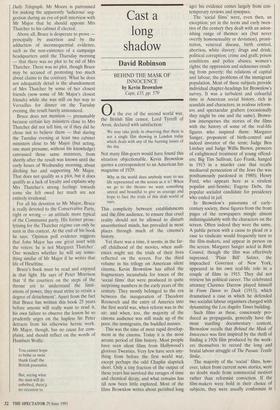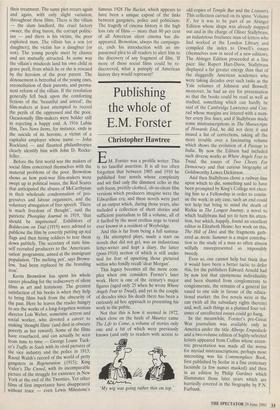Cast a long shadow
David Robinson
BEHIND THE MASK OF INNOCENCE by Kevin Brownlow Cape, £35, pp. 579 On the eve of the second world war, the British film censor, Lord Tyrrell of Avon, declared with satisfaction:
We may take pride in observing that there is not a single film showing in London today which deals with any of the burning issues of the day.
Not many film-goers would have found this situation objectionable. Kevin Brownlow quotes a correspondent to an American fan magazine of 1929:
Why in the world does anybody want to see life represented on the screen as it is? When we go to the theatre we want something unreal and beautiful to give us courage and hope to face the trials of this drab world of ours.
This complicity between establishments and the film audience, to ensure that cruel reality should not be allowed to disturb anaesthetised minds, has prevailed in most places through much of the cinema's history.
Yet there was a time, it seems, in the far- off childhood of the movies, when audi- ences might see the trials of their lives reflected on the screen. For the third volume in his trilogy on American silent cinema, Kevin Brownlow has sifted the fragmentary incunabula for traces of the 'social films' that were produced in quite surprising numbers in the early years of the century. They mostly belonged to the era between the inauguration of Theodore Roosevelt and the entry of America into the first world war, when reform was in the air; and when, too, the majority of the cinema audience was still made up of the poor, the immigrants, the huddled masses.
This was the time of most rapid develop- ment in the cinema. Today it is the most arcane period of film history. Most people have seen silent films from Hollywood's glorious Twenties. Very few have seen any- thing from before the first world war, except perhaps the odd Chaplin slapstick short. Only a tiny fraction of the output of these years has survived the ravages of time and chemical decay; and what remains has till now been little explored. Most of the films Brownlow writes about perished long ago: his evidence comes largely from con- temporary reviews and synopses.
The 'social films' were, even then, an exception: yet in the teens and early twen- ties of the century they dealt with an aston- ishing range of themes: sex (but never overtly homosexuality or deviation), prosti- tution, venereal disease, birth control, abortion, white slavery; drugs and drink; political corruption; crime and graft; prison conditions and police abuses; women's rights; the oppression and sicknesses result- ing from poverty; the relations of capital and labour; the problems of the immigrant population. Most of these subjects provide individual chapter-headings for Brownlow's survey. It was a turbulent and colourful time in American social history, rich in scandals and characters; in zealous reform- ers and spectacular grafters (occasionally they might be one and the same). Brown- low intersperses the stories of the films with the history of some of the real-life figures who inspired them: Margaret Sanger, proponent of birth-control and indeed inventor of the term; Judge Ben Lindsey and Judge Willis Brown, pioneers of enlightened treatment of young offend- ers; Big Tim Sullivan; Leo Frank, hanged in 1913 in a murder case that recalls mediaeval persecution of the Jews (he was posthumously pardoned in 1980); Henry Ford, who appears here as a virulent populist anti-Semite; Eugene Debs, the popular socialist candidate for presidency who ended in jail.
In Brownlow's panorama of early- century society, these figures from the front pages of the newspapers mingle almost indistinguishably with the characters on the screen. Often indeed they were the same. A public person with a cause to plead or a case to vindicate would frequently turn to the film-makers, and appear in person on the screen. Margaret Sanger acted in Birth Control, though the film was effectively supressed. 'Plain Bill' Sulzer, the impeached Governor of New York, appeared in his own real-life role in a couple of films in 1915. They did not retrieve his political career. The celebrated attorney Clarence Darrow played himself in From Dawn to Dusk (1913), which dramatised a case in which he defended two socialist labour organisers charged with dynamiting the Los Angeles Times building.
Such films as these, consciously pro- duced as propaganda, generally have the most startling documentary content. Brownlow recalls that Behind the Mask of Innocence was first inspired by the thrill of finding a 1926 film produced by the work- ers themselves to record the long and brutal labour struggle of The Passaic Textile Strike.
The majority of the 'social' films, how- ever, taken from current news stories, were no doubt made from commercial motives rather than reformist conviction. If the film-makers were bold in their choice of subjects, they were usually conformist in their treatment. The same plot recurs again and again, with only slight variation, throughout these films. There is the villain — the slum landlord, the cruel factory owner, the drug baron, the corrupt politic- ian — and there is his victim, the poor exploited man. The villain has a son (or daughter); the victim has a daughter (or son). The young people meet by chance and are mutually attracted. In some way the villain's misdeeds land his own child in grave peril, from which he or she is rescued by the heroism of the poor parent. The denouement is betrothal of the young ones,
reconciliation of their parents, and perma- nent reform of the villain. If the resolution generally fell back upon the comforting fictions of the 'beautiful and unreal', the film-makers at least attempted to record the perils of the oppressed and the poor. Occasionally film-makers were bolder still in rejecting a happy end. A 1916 Lubin film, Two News Items, for instance, ends in the suicide of its heroine, a victim of a capitalist employer whose name — John Rockland — and flaunted philanthropies clearly identify him with John D. Rocke- feller.
Before the first world war the makers of social films concerned themselves with the material problems of the poor. Brownlow shows us how post-war film-makers were swept up in political issues, the Red Scares that anticipated the abuses of McCarthyism in their wholesale condemnation of pro- gressives and labour organisers, and the voluntary abnegation of free speech. 'There is much freedom of thought', said the patriotic Photoplay Journal in 1919, 'that should be imprisoned'. Exhibitors of Bolshevism on Trial (1919) were advised to publicise the film by covertly putting up red flags and then hiring soldiers to tear them down publicly. The secretary of state him- self recruited producers to the 'Americani- sation' programme, aimed at the immigrant population. 'The melting pot', says Brown- low, 'had been replaced by the branding iron'.
Kevin Brownlow has spent his whole career pleading for the rediscovery of silent films as art and testimony. The greatest satisfaction of his books is when they help to bring films back from the obscurity of the past. Here he leaves the reader hungry to see the works of a long-forgotten woman director Lois Weber, sometime actress and social worker, who devoted a career to making 'thought films' (and died in obscure poverty as her reward). Some of the films have resurfaced, and can actually be seen from time to time — George Loane Tuck- er's Traffic in Souls with its vivid pictures of the vice industry and the police in 1913; Raoul Walsh's record of the world of petty gangsters in Regeneration (1915); King Vidor's The Crowd, with its incomparable picture of the struggle for existence in New York at the end of the Twenties. Yet other films of first importance have disappeared without trace — even Lewis Milestone's famous 1928 The Racket, which appears to have been a unique exposé of the links between gangsters, police and politicians. The tragedy of cinema history is the high loss rate of films — more than 80 per cent of all American silent cinema has dis- appeared. Brownlow, always the campaign- er, ends his introduction with an im- passioned plea to all readers to alert him to the discovery of any fragment of film. 'If more of these social films could be re- discovered, what a panoply of American history they would represent!'



















































 Previous page
Previous page